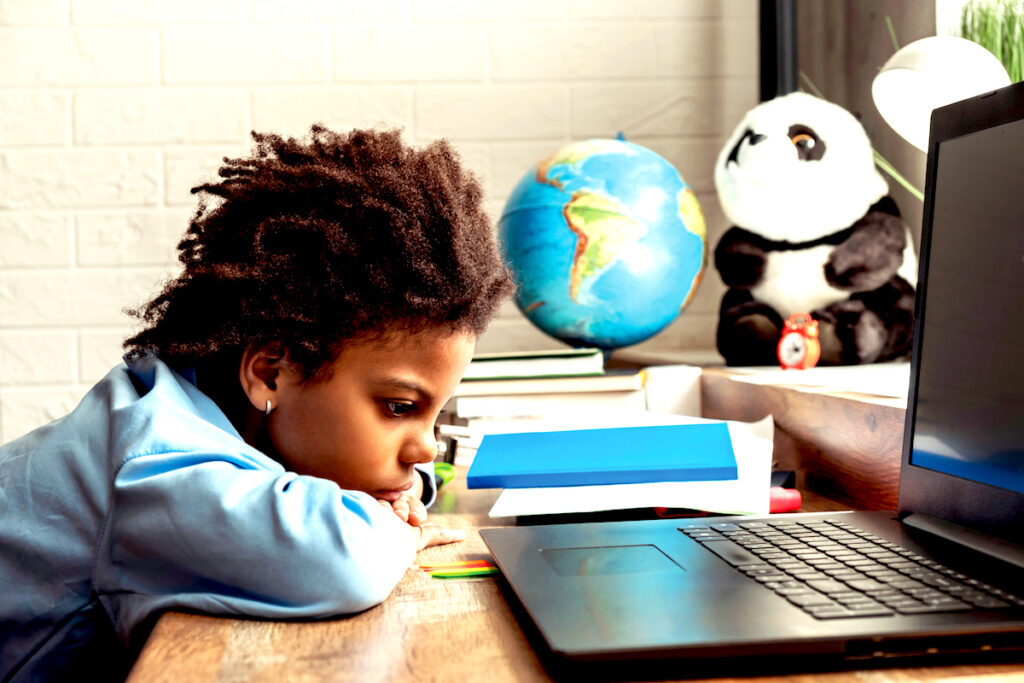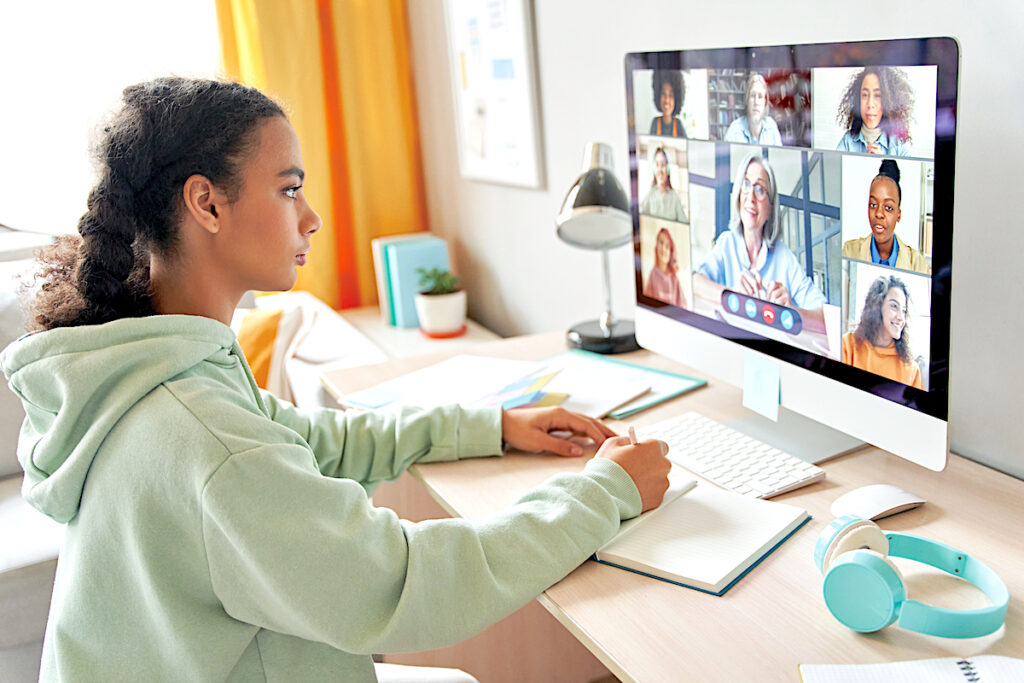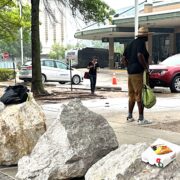



TULSA — Yasmine Enge desperately needed to reach her psychology teacher.
The 2020-21 school year was ending, and the African American senior was ready to complete her requirements to graduate from Union High School.
Psychology was one of four remote classes the 18-year-old was taking. All she needed to complete the class was to take the final exam.
The coronavirus pandemic forced Union Public Schools to discontinue in-person teaching, and Enge was struggling to transition to remote learning.
But first, the teacher needed to unlock the test.
Enge emailed her teacher to request access to the exam. A day passed, then another, and a third. But the teacher wasn’t responding.
Enge had other issues with the psychology class.
It’s not that many of our kids are not skilled at computers, but traditionally, this is not how our community learns.
Francine Campbell, an African American educator and prominent North Tulsa teacher
“It just didn’t seem like there was enough to read,” Enge said in an interview with The Oklahoma Eagle. “The material presented really called for a teacher to help explain it. It was just a lot of notes. It was easy to get lost.”
Eventually, Enge got another teacher to unlock the exam, and she passed.
Her disconnect with her teacher was one of several serious issues Enge had with remote learning. Although she fared better in some of the classes — and ended up with good grades all the way around – the remote experience failed to broaden Enge’s education.
“I didn’t learn that much,” during the distance learning period, she told the Eagle. “My main focus was just to get my work done and graduate.”
Our investigation
The Oklahoma Eagle has conducted a probe into how the COVID-19 pandemic has affected the nearly 33,000 students in Tulsa Public Schools and the surrounding metropolitan area school districts. We conducted more than four dozen interviews with students, parents, administrators and health officials about how the public school community in Tulsa — and surrounding school districts — have fared in the three years of the pandemic. The interviewees were drawn from many Tulsa schools, including McLain, Booker T. Washington High School, George Washington Carver Middle School, John Burroughs Elementary School and Emerson Elementary School. We also interviewed teachers and students from Union Public Schools. And we gathered and analyzed the reports and data prepared by TPS and other sources.
As we gathered information, it became painfully clear just how much the COVID-19 pandemic has wreaked havoc on public school buildings across Tulsa and created deep fissures among parents, teachers and public officials about mask mandates, school closures and remote learning.
We are publishing a three-part series summarizing our reporting results.
- In our first article, Part I, we detailed the impact that the pandemic has had on the disadvantaged school communities in Tulsa. Despite TPS’s attempts to address the demands of the pandemic, a whole generation of students in our underserved communities have fallen dramatically behind in learning.
- In Part II, we examine the devastating impact of the pandemic in schools in North Tulsa and other disadvantaged parts of Tulsa County.
- Part III is devoted to how school administrators make up for the gaps in learning and teaching during the pandemic.

Challenges of remote learning
Enge’s challenges with the distance learning regiment were similar to what many other students in North Tulsa and other underserved communities in the metropolitan area experienced, according to dozens of reports from students, parents and teachers interviewed by the Eagle. In the interviews, students and their families amplified complaints about how the online courses were presented.
Roma Carter, a junior at Booker T. Washington High School in North Tulsa, said she just couldn’t grasp the math problems flashing on her screen and felt lost and anxious with no teacher to consult.
Nataly Gomez, a senior at McLain for Science and Technology in 2020-21, said she did her best to focus on online classes. “But at a certain point you need the classroom, teachers, and classmates,” she lamented. “They give the inspiration and the push you don’t get when you’re isolated in front of a computer.”
The lack of support for distance learning in many North Tulsa households has also been a huge impediment to academic success.
Low test scores as COVID-19 cases continue
After the COVID-19 pandemic hit the United States in March of 2020, Tulsa Public Schools and surrounding schools districts closed all schools for the remainder of the school year, under statewide orders by Oklahoma Gov. Kevin Stitt and the Oklahoma State Board of Education.
In the fall of 2020, TPS sought to re-open schools but abandoned those plans after COVID-19 cases began spiking. In February of 2021, TPS restored in-class teaching. But families and students were also offered the option to engage in distance learning instead of attending classes in-person.
As the third year of the pandemic approaches, TPS offers a hybrid model to class. While classes are primarily in-person, schools affected by high numbers of COVID-19 cases or exposures revert to remote courses.
During the 2022-23 school year, staff shortages or COVID-19 flare-ups required students at McLain and Rogers High School and Emerson and Hawthorne elementary schools and other Northside schools to suspend in-person learning and shift to remote classes.
The on-again, off again in-person teaching means that many students in North Tulsa — and other parts of the city, are still relying heavily on distance learning.
And yet, according to data released by Tulsa Public Schools, the administration’s system for managing schools during the pandemic — centering on distance learning — has had a detrimental impact on student achievement. Student test scores between 2018-19 and 2020-21 school years reflected massive drops in English Language Arts (ELA), math and science. This interval between these academic school years was when remote learning was used extensively. Testing is done earlier in 2022 after in-person teaching had resumed revealed minimal gains against this loss.
Student achievement in low-income areas such as North Tulsa suffered more than others from distance learning, based on research conducted by several prominent national education organizations.
“It seems that the shifts to remote or hybrid instruction during 2020-21 had profound consequences for student achievement,” according to “The Consequences of Remote and Hybrid Instruction During the Pandemic,” a 2022 study by Harvard University’s Center for Education and Policy Research (CEPR) said.
“In districts that went remote, achievement growth was lower for all subgroups, but especially for students attending high-poverty schools. In areas that remained in person, there were still modest losses in achievement, but there was no widening of gaps between high and low-poverty schools in math (and less widening in reading).”

North Tulsa wired to in-person schooling
The foundation of learning in North Tulsa has been centered for decades on a model of up-close classroom interaction. Even younger, computer-savvy North Tulsa students are heavily predisposed to in-person settings with a teacher in command of a room of students. Against that background, the extended reliance on distance learning has been a cultural jolt for many Northside students.
Francine Campbell, an African American educator and prominent North Tulsa teacher, put it succinctly: “It’s not that many of our kids are not skilled at computers, but traditionally, this is not how our community learns.”
Donna Ross, who was named Tulsa Public Schools’ Teacher of the Year in the 2020-2021 school year, concurs with Campbell. “Computer learning was not something any kids or family in our community was prepared for,” she said. “I need to see my kids in my face, and they need to see me. That’s how we have created the basis of trust that allows me to teach and guide them.”
Ross, a fourth-grade teacher at McKinley Elementary School during the first years of the COVID-19 pandemic, worked doggedly with her colleagues to ensure that their students had all the tools they needed to keep up with schooling. Despite their best efforts, an estimated two out of every five students did not engage with the school during the most arduous months of COVID-19, according to estimates by Nani Ware, a McKinley counselor at the time.
Teachers also struggled with remote learning
Enge’s problem reaching her teacher at Union High School illustrated one of the significant flaws that hampered the approach that TPS, Union, and other local areas took: the lack of instructors skilled in online teaching.
While some TPS teachers pivoted quickly from in-class to online teaching, many found it burdensome and challenging, according to self-assessments by some teachers and interviews with parents and students.
“Tulsa teachers have been under enormous pressure throughout the pandemic,” said Shawna Mott-Wright, president of the Tulsa Classroom Teachers Association, in an interview with the Eagle. “Teacher shortages meant they had bigger classes. Some got COVID. They all had to wear masks. On top of all that, teachers of color had to cope with the historical trauma in North Tulsa and everything that comes with that. And then they were asked to teach classes online — a skill set many did not have. It was all too much.”
Besides issues with teachers, students and parents, teachers also cited several other major challenges with TPS’s distance learning regiment. One complaint is that TPS did not require students to appear on screen in classes. That led to the widespread, flagrant skirting of classes. In some cases, students would log in and either go back to sleep or engage in other activities unrelated to classroom instructions, teachers said.
Another issue was with the tools needed to participate in distance learning. TPS vowed to lend every student a Google Chromebook, if needed. But there were students who frequently complained that they were delayed receiving the laptop — sometimes up to three months.
The Eagle made several requests to Tulsa Public Schools for their response to complaints by students and parents. Drew Druzynski, TPS media relations manager, declined the Eagle’s request cited staffing shortages.
Broadband access
Students, parents and educators all emphasized that apart from the flaws in TPS’s system, the lack of support in many households in Tulsa’s underserved communities should not be underestimated. Citizens United For A Better Educational System (C.U.B.E.S.), a North Tulsa-based organization dedicated to improving education, reported that many Northside homes lacked access to broadband internet; in many low-income families, parents were at work during school hours or were not versed in either the curriculum or the learning tools to help.
Even before COVID-19 arrived, Oklahoma’s access to broadband was poor. A 2018 report ranked Oklahoma 47th out of 50 states in terms of average speeds and percent of residents connected, according to a survey by Oklahoma State University Extension.
In Oklahoma, two separate studies found how communities and households struggle to access the internet. The OSU Extension’s survey of Oklahoma’s 509 public school districts also found 24% of students “lacked internet connection at home.”
Another study found that 34% of all households in the state’s urban areas do not have broadband access, according to BroadbandNow’s estimates.
Households in North Tulsa – and other parts of the city from low-income families – were not the only school kids who struggled with the challenges of computer-based distance learning.
Distance learning knows no boundaries
Sarah Ray, a white student from South Tulsa, shared the challenges her family faced. Her parents, both professionals, were also working remotely at home. When the pandemic hit, Ray was a senior and already in a homeschooling program. But suddenly, she found herself housebound with two younger sisters — who are in second and seventh grades — participating in distance learning.
“The Wi-Fi was one thing that was tough,” Ray said. “Everybody was trying to do something online on the computer at the same time. So, we had to determine whose thing was the least important, so that the others could do what they had to do without the computer freezing up while they were on a Zoom call.
“This required a lot of coordination. We had situations where the school system was not connecting with the Wi-Fi, so we had to go to a different room, or I was in the middle of a class, and my mom came in and started asking me questions. Or my sister is on a Google meet for a class, and we have to walk by to get to the kitchen.”
Online math classes were a significant dilemma
It was a weekday afternoon deep in the spring of 2021, and Roma Carter was in a remote math class. Math was a struggle for her, so the 16-year-old junior at Booker T. focused all her energy on the computer as she sat in a chair in her bedroom.
On the screen, there was an equation. Right under it was a mathematical problem. There was no explanation.
The easiest thing in the world was just to Google for the answer.
“She stared at that and things like that, and she would ask for help because she didn’t know how to work through it,” said her brother Cyrus Carter, also a Booker T. student at the time who was often at home also. “And there was nobody there who could help.
“Math is a subject that you need to stay on point,” he explained. “With someone who doesn’t understand it well needs someone to walk them through it. Many teachers will have a chalkboard and write everything down on the chalkboard. You can’t do that online or remotely.
“You can’t do that remotely. So, when that’s all taking place virtually. It loses its authenticity. And when you have your camera off the screen, and the teacher can’t even look at you, it’s an even bigger problem.”

Drop in academic scores
Roma Carter, who is of white and Latin descent, was far from alone in her struggles with learning math remotely.
“Since the pandemic started in March 2020, multiple reports have highlighted significant declines in students’ math and reading achievement and widening gaps by race and school poverty,” the 2022 CEPR study at Harvard concluded.
A comparison of test scores before and during the pandemic showed a dramatic drop in math skills in Tulsa Public Schools.
Butch Fisher, who taught math at Booker T. for over two decades, explained why teaching — and learning math — remotely is particularly hard. “Math is not one of those subjects you can just pour out of a can and add water to and it all works,” Fisher said. “The concepts are complex, and each student approaches them in different ways. You can’t explain them in the generic way you have to do in an online class and expect all or even most students to get it.”
Fisher, an African American and Booker T. class of 1973 graduate, acknowledged that learning math remotely is more complicated for students of color. One reason, he said, is that Black and Brown students often rely on one another for help with complex math problems.
“When they are sitting in a class, one student will turn to another and say, hey, how does this equation work?” Fisher said. “I have seen that happen a lot. Obviously, if you’re sitting at home alone with your computer, you can’t do that.”
Another big reason, Fisher added, is students often turn to adults for some insight into how to solve complex math problems. “But in our community, many of the parents just shrug,” he said. “They don’t have the level of education to help.”
After grappling with teaching math remotely at Booker T., Fisher became exhausted from the challenges. “I continuously found myself thinking there was nothing more I could offer the kids,” he said.
At the end of 2020-21 school year, Fisher retired.
And with him went the institutional knowledge amassed in over four decades of teaching at Booker T.
McKinley Elementary: A study in perseverance
When the pandemic hit, McKinley Principal Lynette Dixon admitted she was at first daunted. But the African American veteran educator did not stew for long. She used the early period of the pandemic, when schools were closed, to gather her team of teachers and counselors to brainstorm ways to overcome the hurdles. McKinley, located on East King Street, has a majority Latino and Black student body. At the time of the pandemic, around 500 kids were enrolled there.
Instead of waiting on directives from TPS administrators, Dixon and her team devised their solutions based on relationships they had built up with students and parents.
“We had to move beyond the shock and figure out how to meet the kids’ needs,” said Ware, who is African American and served as a counselor at McKinley at the time.
“The needs ranged wide, but there was usually a solution,” she said.
Recognizing that school and the teachers were an essential lifeline for many kids, adults were available and accessible at the school daily even when classes were remote. Teachers and staff members took shifts handing out the meals that TPS provided even when no in-person courses were offered.
When one family could not pick up the Chromebooks at a designated location, Dixon or another teacher or staff member would pick it up and bring it. “Lots of technical issues emerged,” Ware explained. “So, we counseled students and parents.
“We saw that a village was needed to help get kids through this. We took on the role of that village.”
The pandemic created emotional issues for McKinley students, too.
When one of her students refused to come on the computer screen, Donna Ross, a popular McKinley teacher, coaxed and coached him. Ultimately, he turned out to be one of the students most engaged in distance learning.
Recognizing that it was up to them to keep kids and family from being isolated, Dixon and others constantly reached out to work. “When we couldn’t get parents or kids on the phone, we knocked on doors,” Ware said.
Dixon and the McKinley team illustrated how a school leadership team could use their willpower and skills to help students with distance learning.
All-out effort
But McKinley’s ability to push through the daunting COVID-19 era was more the exception than the rule. More common are the stories of students who fell two years or more behind in learning comprehension, the teachers who threw their hands up and left TPS, and the parents who grew increasingly frustrated with their inability to help.
The only solution, educators in Tulsa – and nationwide – agree, is for school districts to mount an all-out effort to remedy the learning shortfalls, social woes, and other problems in public schools created by the pandemic.
“School districts urgently need to reassess their plans and ensure that the scale of their catch-up efforts matches the magnitude of their students’ losses,” said Thomas J. Kane, faculty director of the CEPR study conducted at Harvard. “If they don’t, we will see the largest widening in educational inequity in a generation.”
Oklahoma Eagle Correspondent John Neal contributed to this article
About This Series
The series was made possible by a grant from the National Association of Black Journalists. NABJ’s Black Press Grant Program offers funding to support freelance reporters and producers at Black-owned print, broadcast, and digital outlets. The program is supported by a grant from the Chan Zuckerberg Initiative (CZI). Oklahoma Eagle Reporter John Neal contributed to this series.








